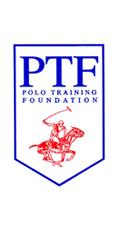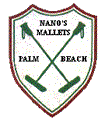It was deemed for the best interest of the game, and all concerned, to form an Association, to be
called the Polo Association, with a constitution and rules to govern all Polo Clubs which should
be elected to membership." This comes from the notes of H.L. Herbert after a March 21, 1890
dinner meeting hosted by John E. Cowdin and attended by a "number of men interested in Polo.
Polo is an ancient sport, well
considered to be one of the oldest sports
in the world. In fact, it can reasonably be
said to be the oldest team sport ever.
Play has been documented in China and
Persia as far back as 600 B.C. And in the
United States, where old is measured in
somewhat less grandiose terms, polo
goes back a long way as well, over 100
years.
Unlike any other sport, the horse defines our game. Next to a
player's skill, the polo pony is the next most important factor
of the game. Some consider the pony to be up to 90 percent of
the game and can be the single greatest determinant of the
outcome of a match.
Once polo was established in the U.S., it didn't take long for
players to recognize the importance of a good horse. Here are
some of the first notable horses in the sport.
Bendigo was a Canadian-bred brown gelding pony. In 1890,
he was described as the best polo pony in the world. He played
for many years, from 1896 by W. S. Buckmaster and
subsequently by Harry Payne Whitney. Bendigo was played by
Whitney in the 1909 International matches, which was won for
the first time by America. Whitney had made it his mission to
acquire the top horses in the world to help win the
Westchester Cup. Bendigo's migration from Canada to
England to the United States indicates the existence of at least
a limited pony trade between the Canadian West and Britain
before the turn of the century.
Texiana (also known as Texina and Texana) was a Texas-bred,
black mare owned and played by Foxhall Keene, rated for years
as the best player in America. She was acknowledged as Keene's best pony
in 1902 and played
under Keene in the
first U.S. Open
Championship in 1904. She was considered to be the fastest
polo pony in the world.
Cottontail was Inducted into the Hall of Fame in 2008. She
was one of the greatest American ponies of the early 20th
century. Owned by Harry Payne Whitney, she was a star and
favorite of his stud in a string of unrivaled ponies. Bred in
California by Lawrence McCreery and later sold to Whitney,
Cottontail was a
grand looking bay
gelding, weighing
about 950 pounds.
He was said to have possessed great power and extreme speed.
By one account, he had a rather plain head, but in some of
those plain heads is infinite horse sense and Cottontail was as
wise as any pony could be.
He was described as having had a good neck, wonderful
shoulders, and well coupled, with beautiful hindquarters.
Standing 15-hands high, he carried Mr. Whitney in the
matches in England in 1909 and at Meadow Brook in 1911 and
1913. Playing outstandingly in each of these hard-fought
contests, he was Mr. Whitney's mainstay, never faltering.
During these years the American team did not lose so much as
a single match.
In the opinion of Mr. Whitney and other men well qualified
to judge, Cottontail was, and would still be considered, the
greatest pony that ever played the game. Whitney and his
beloved Cottontail are joined for eternity as part of the famed
Hazeltine Bronze of the "Big Four" from the 1909
International Matches.
From the personal archives of Brenda Lynn, Museum of Polo
and Hall of Fame |
|
|
|
This year marks the 125th
anniversary of the United States Polo
Association, the national governing body
of the sport of polo. Originally called the
Polo Association, the name was changed
to the United States Polo Association in
1923. Similar to other sport national
governing bodies and major sports
leagues, such as the NFL, MLB, NHL,
USGA and USTA, the USPA governs
rules, handicaps and tournaments in the
U.S. Formed in 1890, the USPA is the
third oldest governing body for a sport
in the U.S., after Major League Baseball
(1875) and the United States Tennis
Association (1881).
James Gordon Bennett, a wealthy
New York publisher, is credited with
bringing polo to the U.S. from England
in 1876. At that time, the game was quite
different then played today with eight or
more players per side and matches
lasting the afternoon.
H.L. Herbert was elected chairman, a
post he held for 31 years. The first
regular meeting of the Polo Association
took place on June 6, 1890. The first
seven clubs were elected to membership:
Country Club of Westchester
(Westchester, New York), Essex County Country Club (Orange, New Jersey),
Meadow Brook Club (Westbury, Long
Island), Morris County Country Club
(Morristown, New Jersey), Philadelphia
Polo Club (Philadelphia, Pennsylvania),
Rockaway Polo Club (Cedarhurst, Long
Island) and Westchester Polo Club
(Newport, Rhode Island).
Two weeks later, on June 18 at Cafe
Savarin, another meeting was held
where discussion included the number
of entries for the Challenge Cup and
having the Referee in important matches
be instructed to enforce rules on foul
riding. The Oyster Bay Polo Club in
Long Island was also elected to
membership without the formal oneweek
notice as required by the
constitution.
A meeting at Cafe Savarin on July 10
of the same year had the association
issuing handicaps to 100 players from
the eight clubs. Handicaps ranged from
0 to 5, with Foxhall Keene (5) and John
E. Cowdin (4) the highest rated.
Rockaway and Westchester Polo Clubs
had the most rated players (15 each)
while Meadow Brook followed closely
with 14. Among the Oyster Bay players
were Theodore, Emlin and Alfred
Roosevelt, all rated 0.
Other discussions included spending
$200 of association funds to purchase
four trophies for the Polo Association
Cups held at Newport; requesting the
Westchester Polo Club offer trophies
valued at $200 for the Newport
Consolation Cups, open to teams beaten
in the Polo Association Cups; and
directing special attention to Rule 23,
requesting delegates to report any
infringement to the executive
committee. Rule 23 prohibited
registered members from playing in
match games with or against clubs that
were not members of the association
without written consent.
Other rules required field size to be
about 750-feet long by 500-feet wide,
limited pony size to no more than 14.1
hands, and required balls to be wood,
with no other covering than paint and
about 3 inches in diameter. The length
of each chukker (15, 20 or 30 minutes)
and numbers of periods were set for
teams of two, three and four players.
Rather than a throw-in, the game began
with a charge, "the contestants taking
their positions behind the chalk line,
which is to be 30 feet from the goal
posts. When the signal to charge has
been given by the referee the first and
second players must keep to the left of
the ball until it has been hit."
Each team chose an umpire and if
necessary, the umpires appointed a
referee, whose decision was final.
The referee had the option of
suspending a player for the match for
foul riding or awarding the opposing
side half a goal.
The rules were tweaked the following
year to address the ball having to go over
and clear the line for it to be considered
out or, if between the posts, a goal; not
striking an opponent with an arm or
elbow during ride-offs; the size and
weight of the ball; dangerous ponies; and
substitutes, among other things. The
charge to start the game was also
replaced with a throw-in.
The Polo Association had its first
controversy, an official protest of the final game of the Alden Cup played at
Cedarhurst on July 9, 1892. With the
score Rockaway 14½, Meadow Brook 14
and just about 10 seconds remaining,
the ball was knocked out. The referee
twice called for the Meadow Brook team
to take the knock-in. R.B. Winthrop of
the Meadow Brook team was outside the
line adjusting his stirrup and preparing
to knock the ball in.
When the time-keepers indicated time
had expired, the referee called the game
and declared Rockaway the winner. Most
of the players left the field and
dismounted, but Mr. O.W. Bird knocked
the ball onto the field and into the goal,
later claiming Meadow Brook was the
winner. He protested the Cup being
awarded to any other team, claiming the
ball was in play when time was called.
A week later it was brought before the
committee, which affirmed the referee's
decision that the Rockaway team won.
By 1894, the USPA had grown to
include 19 clubs from St. Louis to
Philadelphia. By 1897, rules were
revised to allow ponies up to 14.2 hands,
fields to be about 900-feet long by 450-
feet wide and balls could only be painted
white.
Today, the USPA includes nearly 300
clubs in 13 different circuits across the
United States. The level and amount of
polo being played is the highest in the
game's history, generating expansion in
participation and spectatorship.
The celebration continues each month
in 2015 with notable ponies and
milestones decade by decade.
Photos courtesy Museum of Polo |









